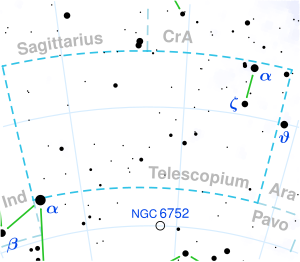Gliese 754
| Observation data EpochJ2000.0EquinoxJ2000.0 | |
|---|---|
| Constellation | Telescopium |
| Right ascension | 19h20m47.98349s[1] |
| Declination | −45° 33′ 29.6292″[1] |
| Apparent magnitude(V) | 12.25[2] |
| Characteristics | |
| Spectral type | M4V[2] |
| Astrometry | |
| Radial velocity(Rv) | +6.8[3]km/s |
| Proper motion(μ) | RA:+659.330[1]mas/yr Dec.:−2,897.035[1]mas/yr |
| Parallax(π) | 169.2351 ± 0.0588mas[4] |
| Distance | 19.272 ± 0.007ly (5.909 ± 0.002pc) |
| Details[3] | |
| Mass | 0.173M☉ |
| Radius | 0.205R☉ |
| Luminosity | 0.005[5]L☉ |
| Temperature | 3,202±100[6]K |
| Metallicity[Fe/H] | −0.169[6]dex |
| Rotation | 132.651 days |
| Other designations | |
| Database references | |
| SIMBAD | data |
Location of Gliese 754 in the constellationTelescopium | |
Gliese 754is a dimstarin the southernconstellationofTelescopium.It has anapparent visual magnitudeof 12.25,[2]which requires a telescope to view. The star is located at a distance of 19.3light-yearsfrom theSunbased onparallax,[1]and it is drifting further away with aradial velocityof +7 km/s.[3]It is one of the hundred closest stars to theSolar System.Calculations of its orbit around the Milky Way showed that it is eccentric, and indicate that it might be athick diskobject.[8]
Thestellar classificationof Gliese 754 is M4V,[2]indicating that this is a smallred dwarfstar on thecorehydrogen fusingmain sequence.It has 17% of themass of the Sunand 21% of theSun's radius.[3]The star is fullyconvectiveand is a source ofX-ray emission.[9]It is rotating slowly with a period of about 133 days.[3]Themetallicityis sub-solar,[6]indicating it has a lower abundance of heavy elements compared to the Sun. It is radiating just 0.5%[5]of theluminosity of the Sunfrom itsphotosphereat aneffective temperatureof around 3,202 K.[6]
Planetary System
[edit]In June 2019, a candidateexoplanetwas reported in orbit around Gliese 754. It was detected using theDoppler methodand is orbiting at a distance of0.28AUwith aperiodof 78 days. The orbit is essentially circular, to within themargin of error.[10]Thehabitable zonefor this star ranges from0.05AUto0.14 AU;[5]inside the orbit of this proposed companion.
| Companion (in order from star) |
Mass | Semimajor axis (AU) |
Orbital period (days) |
Eccentricity | Inclination | Radius |
|---|---|---|---|---|---|---|
| b(unconfirmed) | ≥9.8+4.6 −5.2M🜨 |
0.277+0.025 −0.028 |
78.37+0.55 −0.47 |
0.03+0.20 −0.03 |
— | — |
References
[edit]- ^abcdeBrown, A. G. A.;et al. (Gaia collaboration) (August 2018)."GaiaData Release 2: Summary of the contents and survey properties ".Astronomy & Astrophysics.616.A1.arXiv:1804.09365.Bibcode:2018A&A...616A...1G.doi:10.1051/0004-6361/201833051.Gaia DR2 record for this sourceatVizieR.
- ^abcdHenry, Todd J.; et al. (2018)."The Solar Neighborhood XLIV: RECONS Discoveries within 10 parsecs".The Astronomical Journal.155(6): 265.arXiv:1804.07377.Bibcode:2018AJ....155..265H.doi:10.3847/1538-3881/aac262.S2CID53983430.
- ^abcdeNewton, Elisabeth R.; et al. (November 2018)."New Rotation Period Measurements for M Dwarfs in the Southern Hemisphere: An Abundance of Slowly Rotating, Fully Convective Stars".The Astronomical Journal.156(5): 11.arXiv:1807.09365.Bibcode:2018AJ....156..217N.doi:10.3847/1538-3881/aad73b.S2CID119209638.217.
- ^Brown, A. G. A.;et al. (Gaia collaboration) (2021)."GaiaEarly Data Release 3: Summary of the contents and survey properties ".Astronomy & Astrophysics.649:A1.arXiv:2012.01533.Bibcode:2021A&A...649A...1G.doi:10.1051/0004-6361/202039657.S2CID227254300.(Erratum:doi:10.1051/0004-6361/202039657e).Gaia EDR3 record for this sourceatVizieR.
- ^abcMayor, M.; et al. (2009). "The HARPS search for southern extra-solar planets. XIII. A planetary system with 3 Super-Earths (4.2, 6.9, & 9.2 Earth masses)".Astronomy and Astrophysics.493(2): 639–644.arXiv:0806.4587.Bibcode:2009A&A...493..639M.doi:10.1051/0004-6361:200810451.S2CID116365802.
- ^abcdHoudebine, E. R.; et al. (May 2016)."Rotation-Activity Correlations in K and M Dwarfs. I. Stellar Parameters and Compilations of v sin I and P/sin I for a Large Sample of Late-K and M Dwarfs".The Astrophysical Journal.822(2): 38.arXiv:1604.07920.Bibcode:2016ApJ...822...97H.doi:10.3847/0004-637X/822/2/97.S2CID119118088.97.
- ^"L 347-14".SIMBAD.Centre de données astronomiques de Strasbourg.Retrieved2020-12-12.
- ^Innanen, K.A.; Flynn, C. (2010). "The Radial Velocity, Space Motion, and Galactic Orbit of GJ 754".Journal of the Royal Astronomical Society of Canada.104(6): 223–24.Bibcode:2010JRASC.104..223I.
- ^Wright, Nicholas J.; et al. (September 2018). "The stellar rotation-activity relationship in fully convective M dwarfs".Monthly Notices of the Royal Astronomical Society.479(2): 2351–2360.arXiv:1807.03304.Bibcode:2018MNRAS.479.2351W.doi:10.1093/mnras/sty1670.
- ^Barnes, J. R.; et al. (June 2019). "Frequency of planets orbiting M dwarfs in the Solar neighbourhood".arXiv:1906.04644.Bibcode:2019arXiv190604644T.
{{cite journal}}:Cite journal requires|journal=(help)

